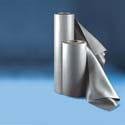Conductive Shielding Material Offers Product Design and Processing Advantages
April 1, 2003
Originally Published MPMN April 2003
INDUSTRY NEWS
Conductive Shielding Material Offers Product Design and Processing Advantages
Norbert Sparrow
|
Industry's first electrically conductive EMI and RFI shielding material supplied in wide, continuous rolls was introduced by Rogers Corp. to medical device |
As electronic devices get smaller and operate at higher frequencies, EMI and RFI shielding must meet ever-more- stringent demands. Acceptable tolerances for even the smallest gaps, seams, or slots in electronic equipment continue to shrink. Rogers Corp. (Rogers, CT; www.rogerscorporation. com) recently introduced what it claims is the first electrically conductive EMI and RFI shielding material supplied in wide, continuous rolls. Described as one of the thinnest and softest such materials on the market, the Bisco EC-2000 series of conductive silicones also features good compression-set resistance, shielding effectiveness, and high yields. The material was presented to the medical device industry at the recent MD&M West show in Anaheim, CA.
The shielding material can be supplied in very thin layers, with cross-sections down to 0.020 in. thick, says Nicole Ouellette, senior product specialist. Available in durometers between 30 and 40 Shore A, the Bisco EC-2000 conductive silicones can replace fabric-over-foam materials in many thin, intricately shaped applications.
EC-2000 silicones are reportedly softer and more compressible than alternative products, making it easier to obtain a good mechanical seal by compressing the gasket. Because it is available in wide, continuous rolls, the material facilitates processing by converters and OEMs. In particular, the wide-roll format eliminates the need to seam molded sheets, thus improving yield. The material is also easy to die-cut, resulting in improved design versatility and decreased time to market.
The conductive silicones are suitable for any device requiring shielding, adds Ouellette, with the exception of products that must use a USP Class VI-rated material. Key medical uses include diagnostic and analytic devices.
Copyright ©2003 Medical Product Manufacturing News
You May Also Like

.png?width=300&auto=webp&quality=80&disable=upscale)

